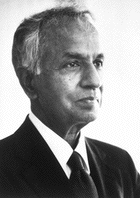Nestled amongst the constellations of scientific luminaries shines the brilliance of Subrahmanyan Chandrasekhar, an Indian-American astrophysicist whose life and work transcended continents and disciplines. Spanning over six decades, his groundbreaking contributions revolutionized our understanding of stars, black holes, and the very fabric of the universe. His legacy, woven into countless research papers, influential books, and a Nobel Prize, echoes through the annals of scientific history, inspiring generations to come.
Born in Lahore (now Pakistan) in 1910, young Chandrasekhar's inquisitive nature blossomed early. By the tender age of 18, he had already published his first research paper, setting the stage for a lifetime dedicated to unraveling the cosmos's mysteries. He embarked on his doctoral studies at the prestigious University of Cambridge, where he encountered his first major hurdle: the Chandrasekhar limit. His meticulous calculations revealed a critical mass for white dwarfs, stellar remnants destined to collapse further if exceeding this limit. His findings, however, met with skepticism and even ridicule from the established scientific community, with renowned physicist Arthur Eddington famously dismissing them.
Undeterred, Chandrasekhar's resolve deepened. He delved deeper into the theoretical labyrinth, refining his calculations and exploring the implications of his proposed limit. Through his relentless pursuit, he realized it hinted at the existence of neutron stars and black holes, celestial bodies deemed too fantastical to be real at the time.
Years later, observations confirmed the existence of these exotic objects, vindicating Chandrasekhar's unwavering belief in his calculations. This wasn't just a personal victory; it marked a paradigm shift in our understanding of stellar evolution and the ultimate fate of massive stars.
Chandrasekhar's brilliance extended far beyond the Chandrasekhar limit. He delved into the intricate dance of energy within stars, the enigmatic formation of planetary systems, and the complex dynamics of binary stars. His work on radiative transfer, the intricate movement of energy through matter, proved instrumental in astrophysics and numerous other fields.
Beyond the realm of groundbreaking research, Chandrasekhar possessed a rare gift for communication. His infectious passion for astronomy shone brightly through captivating lectures and insightful books like "Radiative Transfer" and "The Mathematical Theory of Black Holes." His ability to translate complex scientific concepts into clear and engaging narratives brought the wonders of the universe closer to a broader audience, igniting a spark of curiosity within countless aspiring scientists.
Chandrasekhar's influence stretches far beyond the astrophysical domain:
• Astrophysics: His calculations remain the bedrock of modern stellar evolution models, guiding our understanding of how stars live, die, and transform into diverse remnants.
• General Relativity: His explorations of black holes paved the way for further research into these fascinating objects, shaping our understanding of spacetime and gravity.
• Mathematical Physics: His elegant formulations continue to inspire physicists and mathematicians alike, providing powerful tools for tackling complex problems in the universe.
But Chandrasekhar's legacy goes beyond academic achievements. He embodied the very essence of the scientific spirit. His insatiable intellectual curiosity, relentless pursuit of truth, and unwavering courage in the face of opposition continue to serve as an inspiration for generations of scientists and dreamers. He reminds us that pushing the boundaries of knowledge, even when met with doubts and resistance, can lead to groundbreaking discoveries that reshape our understanding of the universe and our place within it.
As we continue our cosmic exploration, the echoes of Chandrasekhar's work will undoubtedly guide us further. His life and achievements stand as a testament to the power of human intellect, perseverance, and the boundless potential for discovery that lies within us all.


Comments
Post a Comment